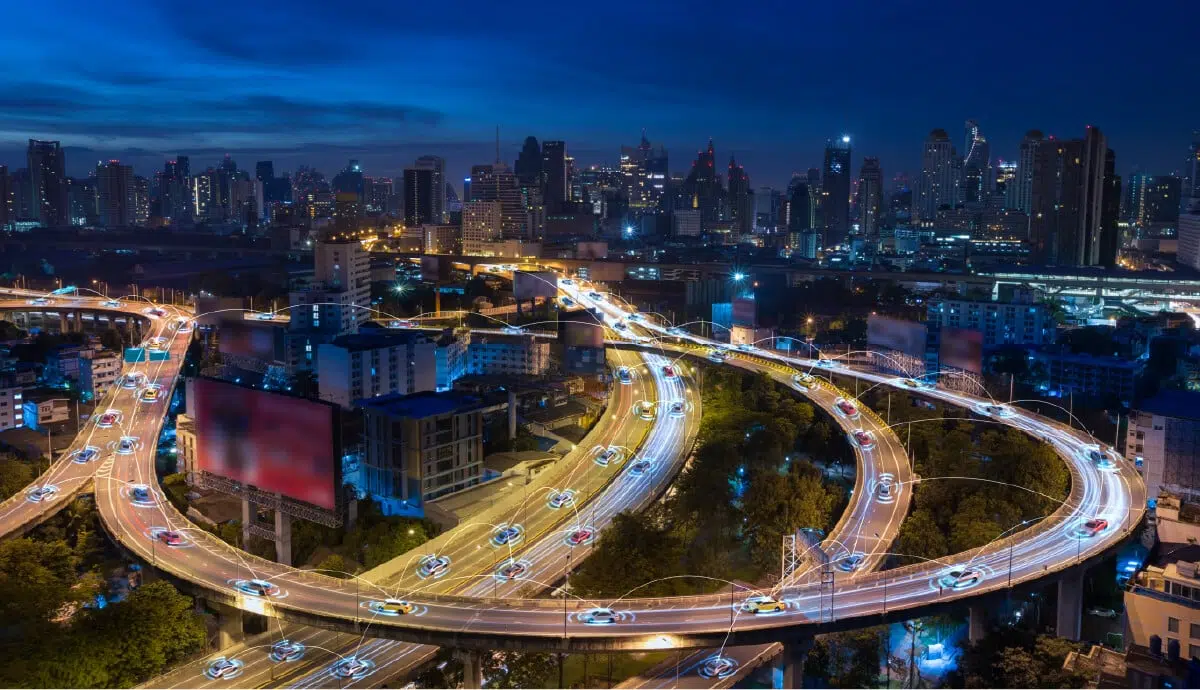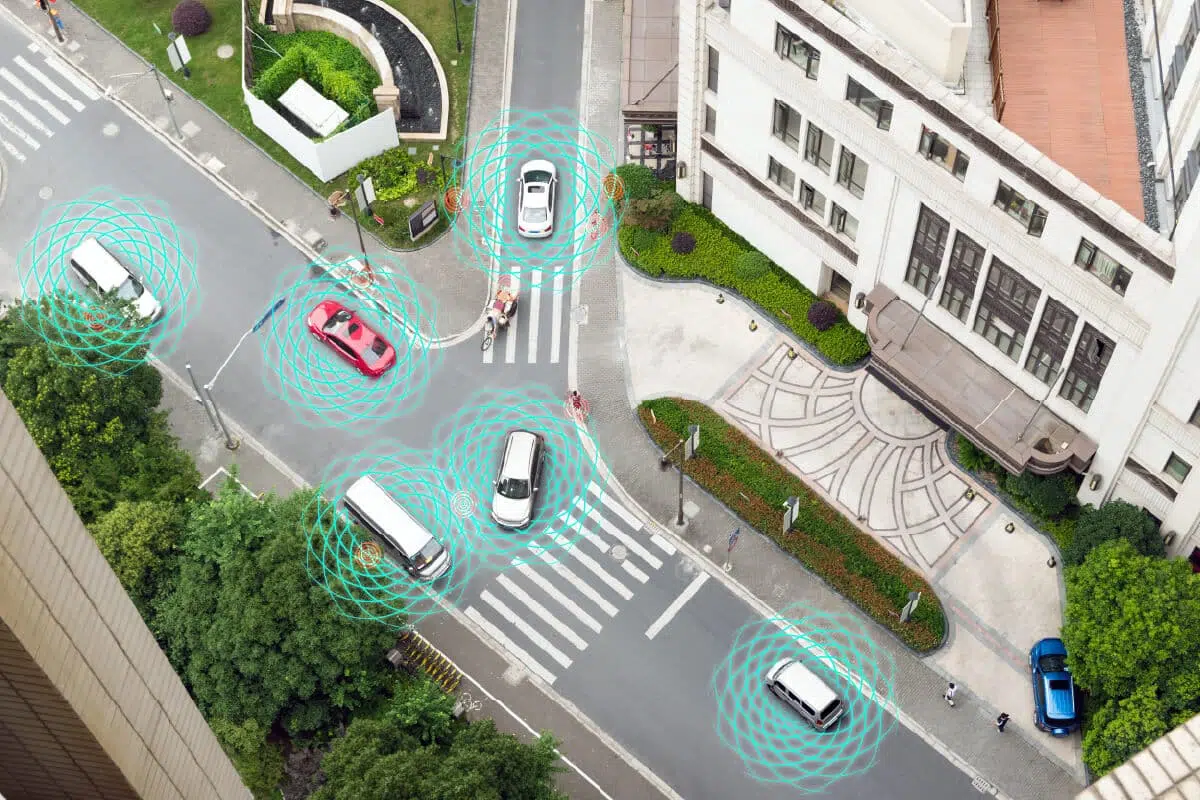- June 3, 2020
- Perspectives
DSRC and C-V2X: Similarities, Differences, and the Future of Connected Vehicles


Douglas Gettman, Ph.D.
Smart Mobility and AV/CV Senior Consultant
From dedicated short-range communication (DSRC) and cellular vehicle-to-everything (C-V2X) technologies to 5G and the 5.9Ghz band, there’s no doubt we’re experiencing a technology evolution. Below, Kimley-Horn’s Doug Gettman, Ph.D. weighs in on connected vehicle technologies, helping you navigate the new landscape and prepare for the future.
What are connected vehicles?
Connected vehicle technologies have been in development for more than 15 years, supported by major investments by the U.S. Department of Transportation Joint Program Office and Federal Highway Administration. Smart City applications for traffic management are focused on connectivity of:
- V2V: vehicle-to-vehicle
- V2I: vehicle-to-infrastructure
- V2X: vehicle-to-everything, including vulnerable road users, such as cyclists and pedestrians
Connected vehicles (CV) include the transmission of data to the vehicle and sharing of vehicle data with infrastructure owner-operators (IOO) (cities, counties, and states responsible for traffic operations) and other nearby vehicles. DSRC and C-V2X are technologies used for very high-speed and high-frequency data exchange (up to 10 times per second with millisecond latency). This communications infrastructure can enable red-light running warnings, rear-end crash protection, curve speed warnings, road weather warnings (like black ice), eco-driving, and personalized traveler information.
What are the similarities and differences between DSRC and C-V2X technology?
The term “cellular” in C-V2X can cause some confusion. “Cellular” in this context does not refer to the use of cellular networks, but rather the use of the underlying electronics in cellular radios adapted to communicate from one radio directly to another. The main similarities and differences between the two technologies are:
Similarities
- Both DSRC and C-V2X use the 5.9Ghz band to directly communicate from one radio to another.
- Both technologies use the same message sets (SAE J2735 and J2945) and use cases.
- Both technologies use digital signatures to ensure security and trust in message providers.
- In both cases, there is no connection between the radios. Each radio is broadcasting the vehicle’s location, speed, acceleration, and other status elements while simultaneously listening to other radios.
Differences
- DSRC uses a wireless standard called WAVE while C-V2X uses long-term evolution (LTE)—the chip technology that almost all cellular phones use. A DSRC radio cannot talk to a C-V2X radio, and vice versa.
- The range of DSRC is typically 300m, and many installations have shown much higher range is possible. Initial tests of C-V2X show that it may have 20-30% more range than DSRC as well as significant improvement in performance with obstructions. While C-V2X initially seems to have better performance, the range and reliability of DSRC is more than adequate for the key safety applications.
How is 5G involved in connected vehicle technology development?
5G generally describes the next generation of cellular chip and base station technology. C-V2X currently uses 4G; 5G C-V2X is in the design phase and includes provisions for multicasting, which is a critical element to reduce radio channel congestion in the not-so-distant future when most of the vehicles on the road are equipped.
Most newer vehicles include a 4G cellular radio for infotainment and to provide a Wi-Fi hotspot for other devices (laptops, handheld games, etc.). 5G networks (traditional cellular networks with base stations) will provide higher data throughput and speed for smartphones and other nomadic devices. Connected vehicle applications can be delivered through 4G and eventually 5G, except the safety-critical V2V and V2I applications, such as electronic brake lights and red-light running warnings. 4G and 5G do not have the guaranteed latency requirements of DSRC or C-V2X.
Newer original equipment manufacturer (OEM) vehicles frequently have 3G/4G cellular links for traveler information, infotainment data, and cell phone hot spots. As 5G cellular services are deployed, most vehicles will utilize these higher speed and bandwidth links as well. It is likely that 5G coverage will be slower to reach rural areas, compared to urban areas. Often, OEMs track the GPS location and status of CVs through these cellular links. Aggregated status data from OEM fleets is now commercially available through data brokers. Many CV applications outside of low-latency active safety applications (red-light running protection, electronic brake lights, etc.) can use cellular connections to deliver messages from IOO. A handful of OEM brokers have demonstrated that signal phase and time (SPaT) data can be delivered to vehicles using cellular with reasonable latency (one to two seconds) to support CV applications such as eco-driving.

What are the advantages and disadvantages of each technology? What trends, drivers, and barriers are influencing their growth?
Differing Opinions
For more than 15 years, the FCC has designated the 5.9Ghz band of the radio frequency spectrum for high-speed, low-latency communications for V2V and V2I. 5.9Ghz is a licensed service for public agencies, so once a user claims the spectrum for their geographical area, no other user can interfere with the safety-critical spectrum.
The National Highway Traffic Safety Administration (NHTSA) has issued a Notice of Proposed Rulemaking for more than five years to mandate DSRC radios on all new vehicles sold in the United States. For a variety of reasons, no rule has yet been enacted. Without a rule, some automakers have dropped their commitment to DSRC, and others have backed C-V2X.
On the infrastructure side for V2I, the American Association of State Highway and Transportation Officials (AASHTO) has promoted the SPaT Challenge and the Connected Fleet Challenge for all 50 states to make relatively small investments in V2I and V2V equipment. AASHTO aims to demonstrate to NHTSA that IOOs are committed to CV technology, primarily DSRC since it is available commercially, while C-V2X is still in the prototyping phase.
Vehicles and the Internet
In the last two years, the C-V2X coalition has maintained that the underlying radio electronics of DSRC are deprecated. Supporters of C-V2X say cellular LTE chipsets are less expensive to manufacture because of their ubiquity and provide an upgrade path for faster and higher performance electronics. For this reason, some auto manufacturers that initially supported DSRC are now in favor of C-V2X. The lack of interoperability makes the NHTSA decision a “VHS versus Betamax” (for those of us who still remember Betamax) or “Blu-ray versus HD DVD” decision.
At the same time, the FCC has been asked by wireless internet service providers (WISPs) to allow use of 5.9Ghz for enhanced Wi-Fi services since the spectrum is adjacent to their current operating band (5.8Ghz) and the allocation is not really being used to date. As recently as March 2020, in response to the COVID-19 crisis, the FCC has allowed WISPs temporary use of 5.9Ghz where it is not already licensed for public agency use to allow them to better provide acceptable service to customers. The FCC’s proposal (if it became permanent) does not disable DSRC or C-V2X completely, but significantly restricts the channel allocation and would require some redesign of how DSRC works.
Scalability
The significant advantage of DSRC is that it has been fully designed, verified to be viable, and is currently being tested in major pilots in New York (dense urban), Florida (suburban-urban), and Wyoming (rural). C-V2X is still yet to be verified to be viable at a large scale (e.g. several thousand vehicles) but uses more modern technology with a clearer path to upgrade performance.
Since both DSRC and C-V2X use the same message payloads and use cases, all V2V, V2I, and V2P applications work the same. However, as discussed above, DSRC radios and C-V2X radios are not interoperable given the differences in the electronics. There are no inherent advantages of one versus another from an application perspective. Side-by-side testing has not yet occurred at a large scale, but we expect to see research results over the next year that may provide additional information on better performance of one technology over the other in certain environments (urban canyons, penetrating obstacles, etc.). As with all scientific questions, the answers should lie in the data, not in rhetoric or political pressures.
If you’re confused, you’re not alone. Even if DSRC was mandated by NHTSA several years ago and automakers were integrating the radios in production vehicles already, C-V2X would likely have come along anyway to disrupt the situation. Connected vehicle technology will begin to penetrate the vehicle fleet at steadily increasing levels over the next 20 years. The efficacy of each CV application depends on the density of vehicles with the CV radio equipment, but many simulations show that even relatively low levels (10%-20%) of CVs can have significant mobility and safety benefits.
How are we helping clients navigate these changes and what advice do you have for those looking to implement infrastructure? Should we be preparing for large scale, city-wide V2X deployments? How does ITS come into play?
Most suppliers of DSRC equipment consider a switch to C-V2X to be a relatively simple replacement of the radio electronics. While it would require a significant amount of effort to change out radios, the costs are relatively low. Agencies like Michigan DOT that have had DSRC equipment deployed for more than eight years, have already faced several rounds of technology changes as the standards have evolved. There may be even further changes to standards based on the outcomes of the New York, Florida, and Wyoming pilots. While frustrating, such technology evolution is all normal and natural, particularly with all the various public and private stakeholders involved.
Kimley-Horn is supporting several agencies in navigating the new landscape at various levels ranging from planning to implementation. Most agencies are appropriately still focused on pilots and technology demonstrations. Since CV equipment is not yet mandated in production vehicles, detailed planning for city-wide deployments does not make a lot of sense at this time, particularly with regards to cost.
Most agencies upgrade their systems in corridors, or small chunks of networks, anyway, so this would naturally include provisions for CVs. Many agencies are considering revisions to their ITS standards so that CV equipment is included in specifications for new field device deployments. For example, new traffic signals could benefit from including modern traffic controllers, roadside units, and switches that support IPv6, and CV radios in the standard technology package. Co-locating CV equipment with other ITS devices (signals, CCTV, DMS, etc.) also allows for some cost savings since the CV equipment can share the cabinet, power, and communications infrastructure.
What about driverless vehicles? Do they need DSRC or 5G?
Automated, driverless vehicles are being developed to largely operate without any real-time data sharing with roadside equipment. This makes sense, because the vehicles cannot expect every traffic signal in the U.S. to have such service for a long time and most metropolitan areas are made up of many cities, counties, and townships. If, for example, a driverless taxi could only operate in the City of Phoenix but not in Scottsdale, it would significantly limit the trips if it couldn’t cross city boundaries. However, a handful of pilot tests are being conducted to use real-time SPaT data with driverless vehicles to reduce the burden on the machine vision systems to correctly detect the color of the traffic signal indications.
In the future, it could be possible that driverless vehicles or highly automated vehicles may provide additional information to an IOO such as 3D lidar or 3D video snapshots. Such information could be useful for incident response and asset management among other potential applications. While some standards are available for 3D imagery and lidar point clouds, the size of such data is prohibitive to share in real-time, at least with existing communication media. 5G cellular may allow such data exchange from driverless vehicles to IOOs.
As connected vehicle technology continues to evolve, we’re here to help. Still have questions? Contact Douglas Gettman.
About the Author

Douglas Gettman, Ph.D.
Dr. Gettman has more than 25 years of experience in automated transit, Smart Cities, internet of things, big data tools, connected vehicles, automated vehicles, adaptive traffic control, intelligent transportation systems management software (central and field controller), and transportation system modeling and simulation. He has experience directing development and integration of mobile, desktop, and web systems for transportation management, planning, and engineering innovation. Dr. Gettman has also developed, deployed, integrated, and supported adaptive traffic control, Smart City, and IoT systems for cities, counties, and state DOTs across North America. He has been the principal investigator for FHWA and NCHRP programs in adaptive control, traffic signal operations, big data, and automated and connected vehicles. Dr. Gettman has experience applying major traffic simulation systems including Vissim, Corsim, VISUM, and ALPS for freeway, arterial, and airport operations studies. He is author or co-author of more than 30 peer-reviewed research papers and FHWA reports.
